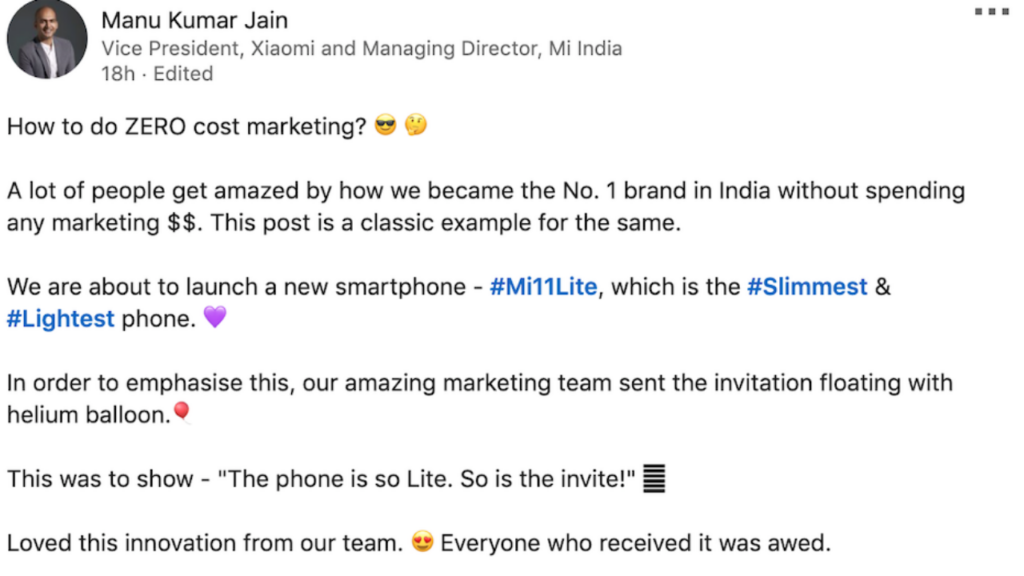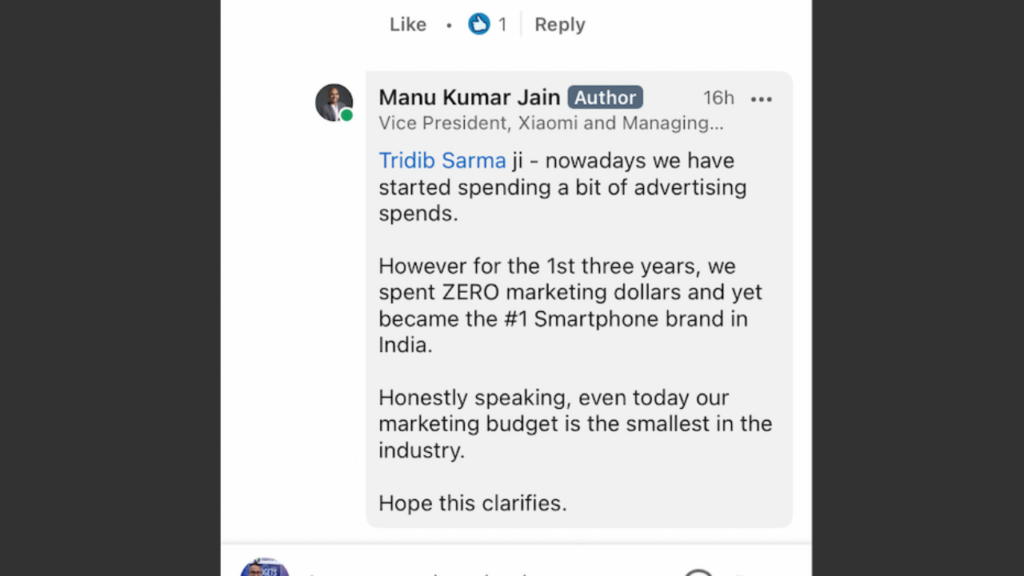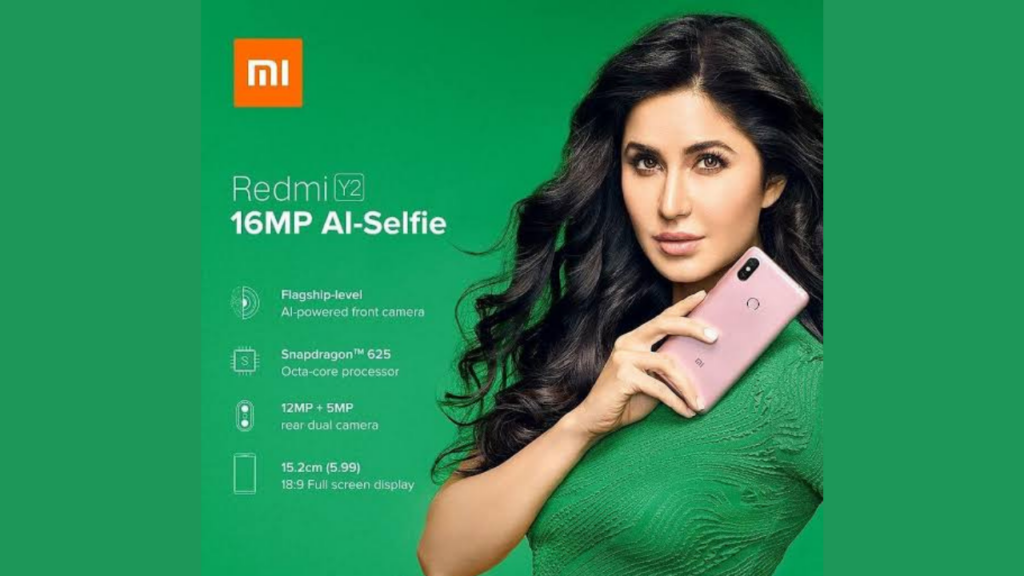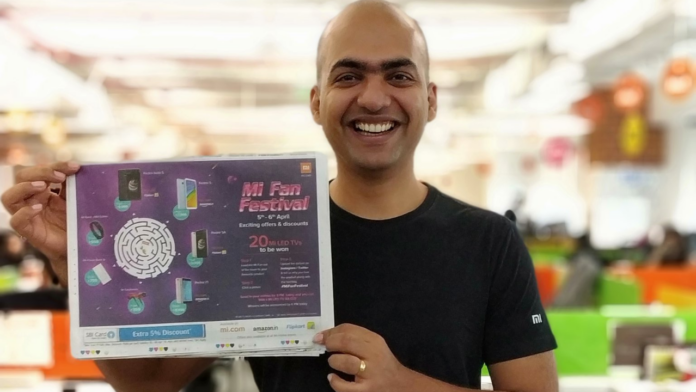Xiaomi, the China-based smartphone major, carved out a name for itself in many parts of the world, including India, where the company even overtook the long-standing leader, Samsung, back in 2018.
Ever since Xiaomi started its India journey in July 2014, a recurring theme that the firm has been happy to paint is that it spends little to zero advertising costs. Is that really true?
MD of Xiaomi India, Manu Jain, has regularly gone public with claims of its ‘Zero’ cost and ‘Honest Pricing’ on the marketing and advertising of its products. The most recent one was made through a LinkedIn post when talking about how the marketing team sent the invitations for its latest smartphone launch. But are these claims legit, considering anyone linked to the mobile phone industry knows that advertising plays a major role in boosting a company’s sales?

Xiaomi is obviously spending a considerable amount of money on advertising as its ads are visible all over social media, YouTube, newspapers, TV and other platforms. When Jain claimed LinkedIn, a user wrote, “Manu Kumar Jain come on now. I am not able to watch a single video peacefully at YouTube just because of repeated ads of Mi 11 lite.”

To this, Manu Jain replied, “Nowadays we have started spending a bit of advertising spends. However, for the 1st three years, we spent ZERO marketing dollars and yet became the #1 Smartphone brand in India. Honestly speaking, even today, our marketing budget is the smallest in the industry. Hope this clarifies”.
Some of Jain’s claims clearly backfired, but he stood firm on his words by saying that the spending on advertising was Zero for the first three years. So let’s dig a bit deeper to verify if the claims made by Jain are legit or not.
2014, The Beginning
Xiaomi entered the Indian market in July 2014 with the Mi 3. This was sold in a partnership with Flipkart, the beginning of the firm’s exclusively ‘online+value’ pitch. At the launch event, the personality that took the show was Hugo Barra, who was the vice president of product management at Xiaomi at the time. This was something big for Xiaomi, considering Barra worked as a product spokesperson for Android at Google before.
The Mi 3 was the first device by Xiaomi to be sold in India in partnership with Flipkart. The phone created a lot of buzz due to its value for money characteristic. It was sold out in a few seconds during the first sale as Xiaomi had only made available a limited amount of units for sale.
Back then, we agree that Xiaomi didn’t spend much on advertising and relied on word-of-mouth, meaning it lets its products do the talking so fans can recommend the company’s products to other people. The other aspect on which Xiaomi heavily relied was Social Media, where the company promoted the product on its own Facebook page and through other platforms. As a result, it was way ahead of rivals when creating a cohort of dedicated fans or using influencers. Most of these fans are happy with a gift from the firm when they liked the products in any case.
According to IDC, Xiaomi handsets were four percent of the total smartphone shipments in India during the final quarter of 2014, while market leader Samsung had 22 percent. Considering it had just been a matter of a few months since its first smartphone launch in India, 4 percent was still an imposing start.
2015
The first year went by, and then in 2015, Xiaomi was growing and matured more as a smartphone maker in India. Though its word of mouth tactics and social media reliability had come to a saturation point, the company went on to grow because of its low-cost value for money smartphones. The Xiaomi buzz machine kept improving meantime, with stylish launches and more.
Almost a year later, on June 19, 2015, the then VP of Xiaomi, Hugo Barra, shared a tweet saying that the company had published its first-ever print ad, a full-page colour advertisement on page one of the Times of India, to promote the Mi 4, its flagship smartphone of 2015. This was done to explore more strategies for advertising as its existing tactics weren’t working well for the company, and it had to reach a wider audience in the country, considering it was still young and was just a year old.
Back then, a full front page ad on TOI newspaper cost Rs 73,71,850 in Bangalore, where the newspaper reached a population of 5,17,568. Interestingly, back then, Xiaomi Executive Kong Kat Wong had said in an interview that, “We don’t rely on the traditional advertisement to sell our product, we actually rely on the products to sell themselves. If the product is attractive, you can actually get a lot from word of mouth”. This ad was posted almost a year since Xiaomi came to India, which contradicts Manu Jain’s recent claim that Xiaomi did not spend on advertising in the first three years of the company’s presence in the country. And watch that phrase, ‘word of mouth’, as the company started courting the youth segment carefully, giving away generous freebies to bloggers and other minor influencers.
2016
Coming to 2016, Xiaomi changed its advertising strategy once again. Its first-ever TV commercial went on-air on channels in which the company showcased its Redmi Note 3 smartphone. Xiaomi had now come a long way since the online-only business model that is followed in the initial year. So, of course, the move to TV was natural for any firm that seeks a significant market share in India.
The company had partnered with Amazon for the 30-second commercial, which highlighted the smartphone as well as how easy it was to purchase it via Amazon. However, as the ad was created in partnership with an e-commerce website, Xiaomi did have to pay a good amount to the service and TV commercials can cost thousands to lakhs of rupees for a 30-sec video.
Xiaomi claimed that it crossed $1 billion (Rs 6800 crore back then) worth of revenue in India during 2016. It sold over 2 million smartphones in Q3 of 2016, claiming 150 per cent year-on-year growth. The Redmi Note 3 sold 2.3 million devices in six months, as per Manu Jain, making the Xiaomi smartphone the most shipped device being sold online in the particular time period. An IDC report had also claimed that Xiaomi, for the first time, made it to the top five smartphone vendors list based on shipments.
2017
This was a big year for Xiaomi as by Q3 of 2017, Xiaomi boosted its market share in India’s smartphone market to 23.5%, placing it on par with Samsung in the smartphone segment as per a Canalys report. Moreover, Xiaomi beat out Samsung as the No.1 smartphone vendor in India by shipments in Q4 2017. It had shipped 8.2 million smartphone units in Q4 of 2017 compared to Samsung’s 7.3 million smartphone units. By now, Xiaomi and Manu Jain himself had a powerful social media presence, with a legion of fans that got preferred treatment at launches and spread the word about the firm’s phones widely.
But it was also the year when Hugo Barra departed from Xiaomi and went on to join Facebook the same year itself. Manu Jain had taken the position of VP as Barra left.

Later in 2017, Xiaomi announced Bollywood actress Katrina Kaif as its product endorser for the Redmi Y series, which again accounts for marketing and advertising spends. Manu Jain, at that time, said in a statement, “The Redmi Y series is designed for people who need a smartphone that can complement and enhance their everyday routine and lifestyle. We are excited to have Katrina as our product endorser for the Redmi Y series. Katrina is one of those individuals who works extremely hard to complement each and every situation she is a part of. It’s extremely synonymous with what the Redmi Y series stands for”.
As seen above, the first three years were crucial for the company, and it did spend a significant amount of money on advertising so as to grow further and deepen its roots in the Indian region. However, one would have to say that this figure was much lower than the market leader Samsung and possibly other competitors, simply because Xiaomi, with its digital-first approach, seemed to understand the effectiveness of its spending better. As an out and out a youth-focused brand, it was also logical to keep building on its digital momentum.
2018
As we advance in 2018, as per International Data Corporation (IDC), Xiaomi shipped 11.7 mn smartphones and became the top brand in the Indian market with 27.3% in the third quarter of 2018. It beat Samsung again to stay at the top position in India. In the first quarter of 2018, Xiaomi had a 31 per cent share in smartphones as compared to 26 per cent for Samsung. Now, this won’t be possible unless the advertising cost of Xiaomi remained high.
2018 was the year Xiaomi launched the Redmi Note 5 series and started a whole ad campaign called ‘Naya Note’ for the smartphone. At that time, Manu Jain, while commenting on the ad campaign, said, “Choosing the Naya Note idea was a conscious effort from our side to highlight Xiaomi’s widespread popularity, which Indians can relate to in their daily lives. Redmi Note 5 Pro is already a leader in its market space and is loved by many. We hope that our campaign can further elevate our consumers’ intimate connection with Xiaomi as a brand and relate with the Redmi Note series at the same depth as they do with the term “Naya Note”.
This is another example of how Xiaomi was spending ‘$$’ on ad campaigns. The ads ran across Television, YouTube and all other social media channels.
During this year itself, another campaign Xiaomi started was for the Mi A2. The campaign called ‘Perfect Moments Don’t Wait’ that was conceptualized by Ogilvy ran across different channels, which included television, digital media and print media. A second video was also released later on. This was also the time when the OnePlus brand hit top gear in India, with spends across media and its flagship killer pitch. Xiaomi had to respond, and it did, by spending big finally.
Another ad campaign it started was titled ‘Kiska Baja’, which focused on Xiaomi’s trademark ringtone, which people may hear during their day-to-day lives while travelling, working, etc. The campaign aimed at portraying the strong presence of the brand in India and how it had a widespread reach in the country.
This year, Manu Jain himself posted a tweet on the 5th of April, asking the Xiaomi fans to check out the newspaper ad on the front page of Times of India regarding the MiFanFestival giveaway held during that period on the occasion of the company’s birthday. This was another one of those instances when the advertising cost had been kept high by Xiaomi.
2019
By 2019, Xiaomi was a full-fledged company into advertising the same as any other smartphone company out there. The brand roped in Ranveer Singh as an endorser for its Redmi Note 7 series. The ads for these smartphones ran across Television channels as well as on YouTube and other social media platforms.
Marking the launch of the new campaign, Anuj Sharma, chief marketing officer, Xiaomi India, said, “Xiaomi’s Redmi Note series has a notable legacy of its own and plays a significant role in driving the brand’s leading performance in India. Therefore, there couldn’t have been a better way to present our all-new Redmi Note 7 Pro by combining our brand marketing efforts with one of the major superstars of this generation, Ranveer Singh”.
Then later in the year, when the brand revealed the Redmi K20 Flagship series, it launched a new brand marketing campaign, True Master, promoting the Redmi K20 Pro. This was again aired across television and social media platforms, further proving how much Xiaomi was into the advertising of its products.
A new TV commercial for the Mi A3 that was launched in August of 2019 was also released that highlighted the smartphone features, especially focusing on the camera.
2020
During this year, Samsung took back its number 1 position and dethroned Xiaomi to get to the top in terms of sales and shipments during the third quarter of 2020, capturing 24 percent of the world’s second-largest smartphone market.
Before this, Xiaomi was at the top for three years as the number 1 smartphone brand in India. However, Samsung LED by just 1% and had a 24% share in the Indian smartphone market, whereas Xiaomi had 23%. Moreover, the anti-China sentiment had started to arise amongst the citizens that may have been a cause for the drop in percentage share.
The brand had started a new ‘Kiska Hai’ ad campaign that aired across television for its Mi TV series in India. The company also partnered with many leading digital celebrities such as Aparshakti Khurana, Kenny Sebastian, Radhika Madan, Regina Cassandra, Namit Das, Angira Dhar & Anindita Bose for their digital film that launched during the Diwali season in 2020 and was a part of ‘DiwaliWithMI’ campaign. In addition, the brand has also partnered with musicians such as Baba Sehgal and Rupam Islam to launch new soundtracks with a festive vibe.
Conclusion
We are halfway through 2021, and Xiaomi still has a long way to go in the year where the company may start new ad campaigns or it may not. But the fact that the Chinese company has started a bunch of ad campaigns in the past from the 1st year itself since its inception makes it known that Xiaomi did spend a lot of advertising costs and by no means the claims that mention the advertising budget of the company has been kept Zero, are true.
However, the firm deserves credit for spending much less per phone sold and using social media and its legion of influencers to massive effect. “


